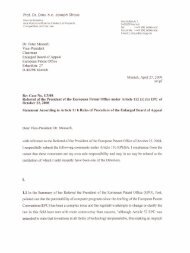Assessing the Obstacles to Industrialisation: The ... - Innovation
Assessing the Obstacles to Industrialisation: The ... - Innovation
Assessing the Obstacles to Industrialisation: The ... - Innovation
You also want an ePaper? Increase the reach of your titles
YUMPU automatically turns print PDFs into web optimized ePapers that Google loves.
joStephen Ei. Eiaberoccurred as well. On an aggregate level, real expenditures on private fixedcapital formation were I 67 % higher in I 9 3 9 than <strong>the</strong>y had been in I 9 3 2.Part of this increase in capital spending was <strong>the</strong> result of modernisationprogrammes undertaken in older industries. <strong>The</strong> value of <strong>the</strong> physicalplant of <strong>the</strong> Fundidora Monterrey steel mill, for example, increased by3 j % between 1934 and 1937. <strong>The</strong> value of <strong>the</strong> physical plant of <strong>the</strong> majorcot<strong>to</strong>n textile producer, <strong>the</strong> Compadia Industrial de Orizaba, almostdoubled during <strong>the</strong> same period, increasing by 98°/~.76Of equalsignificance <strong>to</strong> <strong>the</strong> renewed investment programme of older industries was<strong>the</strong> creation of new firms. Basically, <strong>the</strong>se new companies did not enterin<strong>to</strong> competition with <strong>the</strong> old established giants. <strong>The</strong>y left beer brewing,steel-making, paper milling, and o<strong>the</strong>r capital-intensive, verticallyintegrated operations <strong>to</strong> <strong>the</strong> companies that had dominated those lines ofmanufacture since <strong>the</strong> Porjria<strong>to</strong>. Instead, <strong>the</strong> new entrants <strong>to</strong> <strong>the</strong> marketconcentrated on new products, like rayon knitwear, cot<strong>to</strong>n knitwear, silkand high-grade cot<strong>to</strong>n shirtings, hosiery and o<strong>the</strong>r goods that had beenimported up until <strong>the</strong>n. In fact, of <strong>the</strong> 692 firms listed in <strong>the</strong> 1938 taxregistry of <strong>the</strong> textile industry, well over half were involved in <strong>the</strong>manufacture of <strong>the</strong>se new product^.^'Manufacturing, in fact, came <strong>to</strong> lead <strong>the</strong> economy at this point, withvalue added in this sec<strong>to</strong>r growing 14j % faster than GDP as a whole."In fact, for <strong>the</strong> next forty years manufacturing was <strong>the</strong> engine of growthof <strong>the</strong> Mexican economy. In this round of Mexican industrial developmentnew obstacles <strong>to</strong> growth presented <strong>the</strong>mselves, and many of <strong>the</strong> oldobstacles continued <strong>to</strong> persist. As had occurred in <strong>the</strong> earlier period, <strong>the</strong>seshaped both <strong>the</strong> rate and structure of industrialisation, and prevented,once again, a self-sustaining process of industrialisation from taking hold.Although Mexico did not become an industrial society until <strong>the</strong> secondhalf of <strong>the</strong> twentieth century, a significant amount of industrialisation wasachieved in <strong>the</strong> nineteenth century - particularly during <strong>the</strong> 20 years from1890 <strong>to</strong> 1910. Even as early as <strong>the</strong> 1830s Mexican policy-makers andentrepreneurs attempted <strong>to</strong> copy <strong>the</strong> experience of Western Europe byintroducing modern technology and modern organisational arrangementsin <strong>the</strong> cot<strong>to</strong>n-textile industry. hlexico's low level of nineteenth-centuryindustrial growth was not <strong>the</strong>refore a product of not wanting <strong>to</strong>industrialise.ifi Cardenas, I*a zndusfriali~acidn twexicana, p. 144: Haber, Industcy and Ihderdei~elopment, ch.10." Secretaria de Hacienda y Credi<strong>to</strong> Pliblico, 'Direc<strong>to</strong>r10 de las fabricas de hilados ytejidos registrados ' (Mexico, 1918).'"irdenas, I,a industriaii?acio'n mexicana, p. 10.





